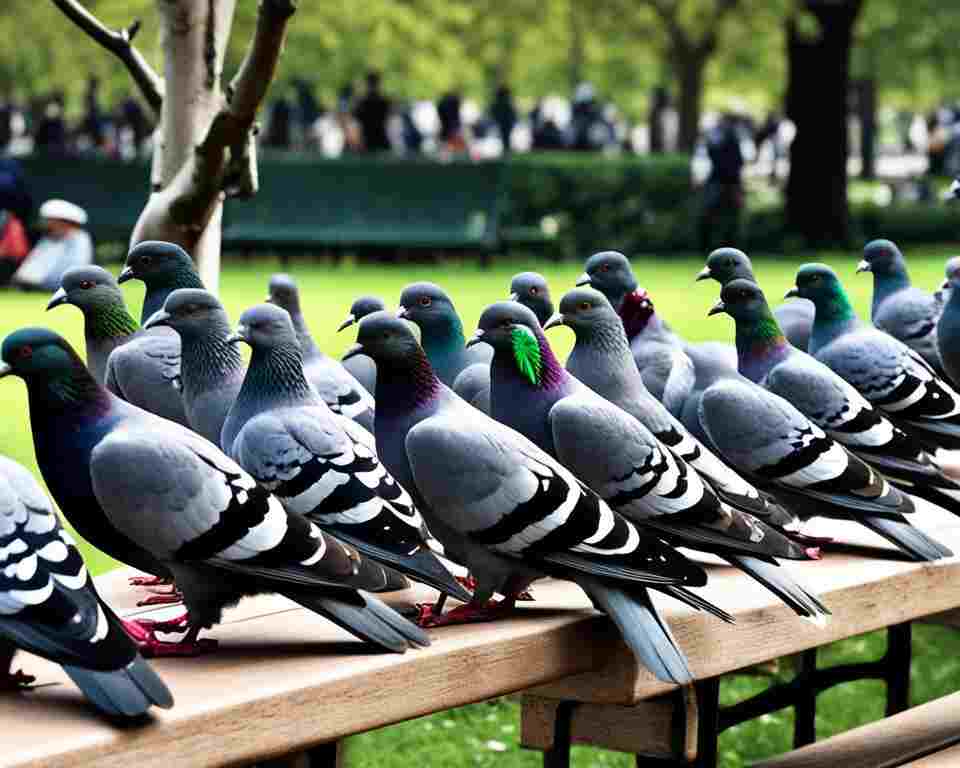Get ready to discover the amazing world of pigeons! These birds, often overlooked, have incredible qualities that will surprise you. As the first domesticated bird, pigeons have a rich history, and their intelligence and unique behaviors make them truly fascinating.
Join us to learn lesser-known facts, peculiar behaviors, and quirky tidbits about pigeons. You’ll come away with a newfound appreciation for these extraordinary creatures.
Table of Contents
Key Takeaways:
- Pigeons have a rich history as the first domesticated bird and have been kept as pets for thousands of years.
- They have served as messengers in the military and played a significant role in communication systems throughout history.
- Pigeons possess exceptional navigational skills and can find their way home from incredible distances.
- They have unique biological characteristics, such as producing “milk” for their young and the ability to recognize themselves and differentiate between humans.
- Pigeons exhibit surprising intelligence and have been known to detect cancer, showcasing their remarkable abilities.

The First Domesticated Bird
Pigeons have a long history of being kept as pets and are believed to be the first domesticated bird. These fascinating creatures have been companions to humans for thousands of years, forming a unique bond that has stood the test of time. In fact, images of pigeons can be found in ancient Mesopotamian art dating back to 4500 BCE, showcasing the enduring relationship between humans and these feathered friends.
Not only have pigeons been beloved companions, but they have also played a significant role as a food source throughout history. Their meat has been consumed by various cultures, demonstrating the versatility and value that pigeons have provided to humans over the centuries.
Pigeons’ status as the first domesticated bird highlights their historical importance and their unique place in human society. Let’s delve deeper into the characteristics, behavior, and fun facts about these amazing creatures.
War Veterans
Pigeons have a rich history of serving as war veterans, playing a crucial role in military operations. These brave birds were commonly used as messengers during the 20th century. They delivered important messages between bases and even across enemy lines, often in dangerous and challenging conditions.
Two notable war veterans among pigeons are G.I. Joe and Cher Ami. G.I. Joe, a pigeon in World War II, carried a vital message that prevented the bombing of a town in Italy, saving countless lives. Cher Ami, a pigeon in World War I, delivered a message that rescued a lost battalion and prevented friendly fire. These heroic actions showcase the remarkable dedication and intelligence of pigeons in their duties as messengers.
Pigeons’ ability to navigate long distances and deliver critical information with speed and accuracy made them invaluable assets during wartime. They played a vital role in communication, surpassing other forms of technology available at the time. Pigeons truly served as unsung heroes on the battlefield, their contributions often overlooked but essential in protecting lives and conveying vital information.
Pigeon War Veterans
Here is a list of notable pigeons that served as war veterans:
| Name | War | Role |
|---|---|---|
| G.I. Joe | World War II | Bombing prevention |
| Cher Ami | World War I | Lost battalion rescue |
| Mary of Exeter | World War II | Message delivery |
| Paddy | World War I | Message delivery |

These war veterans demonstrate the exceptional capabilities and contributions of pigeons in history. As messengers, they carried vital information that saved lives and influenced crucial military operations. Their bravery and intelligence exemplify the remarkable bond between pigeons and humans in times of conflict.
Life-saving Abilities
Not only have pigeons played a crucial role as messengers in military history, but they have also been instrumental in saving lives outside of the military. These remarkable birds have been trained to aid in rescuing people lost at sea, utilizing their unique set of skills and characteristics to locate and alert rescuers to stranded individuals.
Pigeons possess excellent eyesight, allowing them to spot people in distress from great distances. What makes them even more exceptional is their ability to detect ultraviolet light, which is invisible to humans. This allows pigeons to see patterns and contrasts that are undetectable to the naked human eye, making them ideal candidates for search and rescue operations.
When a person goes missing at sea, time is of the essence. Pigeons’ natural homing instincts and navigational abilities enable them to cover vast distances swiftly and accurately. Their uncanny sense of direction allows them to pinpoint the location of stranded individuals, ensuring that rescuers can reach them in a timely manner.
Pigeons’ life-saving contributions extend beyond their physical capabilities. These birds have earned a special place in people’s hearts with their ability to provide comfort and companionship during challenging times. The remarkable bond that develops between rescuers and pigeons is a testament to the compassion and empathy displayed by these extraordinary creatures.
Next time you see a pigeon perched on a ledge or flying overhead, take a moment to appreciate their unique characteristics and the invaluable role they play in saving lives.
Pigeon Life-saving Abilities:
- Exceptional eyesight
- Ability to detect ultraviolet light
- Uncanny sense of direction
- Swift navigation skills
- Compassionate companionship
| Life-saving Abilities | Examples |
|---|---|
| Pigeons’ excellent eyesight | Able to spot people in distress from great distances |
| Pigeons’ ability to detect ultraviolet light | Allows them to see patterns and contrasts invisible to humans |
| Pigeons’ uncanny sense of direction | Enables them to locate stranded individuals accurately |
| Pigeons’ swift navigation skills | Allows them to cover vast distances in a short amount of time |
| Pigeons’ compassionate companionship | Provides comfort and empathy during challenging times |
Pigeons possess remarkable navigation abilities, making them renowned for their incredible homing instincts. These feathered creatures can navigate their way home from distances as far as 1,300 miles, even after being transported in complete isolation. Scientists are still working to unravel the secrets of how pigeons accomplish this extraordinary feat, but it is believed that they rely on a combination of compass mechanisms and maps in their brains.
These navigation skills have made pigeons invaluable as messengers and impressive racers. Their uncanny ability to find their way home with such accuracy and precision has fascinated researchers for centuries.
One of the prevailing theories behind pigeons’ navigation skills involves their utilization of internal compass mechanisms. These mechanisms enable pigeons to perceive the Earth’s magnetic field and use it as a reference point for orientation. By aligning themselves with the magnetic field, pigeons have a built-in compass that guides them in the right direction.
In addition to their magnetic compass, pigeons are believed to rely on maps imprinted in their brains to navigate. These cognitive maps allow them to have a mental representation of their surroundings and plot their course accurately. The combination of compass mechanisms and map navigation provides pigeons with a formidable navigation system.
Implications in Practical Applications
Pigeons’ navigation skills have not only captured the curiosity of scientists but have also been applied in practical ways. Historically, pigeons were used as reliable messengers, carrying important letters and critical information across vast distances. Their ability to return home with speed and accuracy made them an indispensable means of communication.
Furthermore, pigeon racing has emerged as a popular sport where owners release their pigeons from a specific location, and the bird that returns home first wins. This sport showcases the impressive navigation skills that pigeons possess and highlights their exceptional abilities in finding their way back to their lofts.
Pigeons’ navigation skills stand as a testament to their remarkable capabilities as avian adventurers. Their innate ability to navigate over vast distances, even when faced with unfamiliar surroundings, is an awe-inspiring marvel of the natural world. As we continue to study and unravel the intricacies of pigeon navigation, we gain a deeper appreciation for these extraordinary birds.
| Pigeon Navigation Skills | Description |
|---|---|
| Distance Covered | Pigeons can find their way home from distances as far as 1,300 miles. |
| Mechanism | Pigeons use a combination of compass mechanisms and cognitive maps. |
| Internal Compass | Pigeons have a built-in compass that allows them to align with the Earth’s magnetic field. |
| Cognitive Maps | Pigeons possess mental representations of their surroundings, helping them navigate their way back home. |
| Practical Use | Pigeons were historically used as messengers and are involved in racing sports. |

Speed and Racing Pigeons
When it comes to speed, few birds can rival the astonishing agility of pigeons. These remarkable creatures have been utilized as messengers and racing pigeons throughout history, primarily due to their impressive speed and endurance. Pigeon racing, in particular, has evolved into a flourishing sport, with pigeons fetching high prices based on their exceptional racing capabilities.
What makes pigeons such fast flyers? One key factor lies in their unique characteristics. Pigeons possess powerful chest muscles and aerodynamic bodies, allowing them to generate strong wing beats and maintain an optimal gliding position. Additionally, their lightweight feathers reduce drag and enable them to maneuver swiftly in the air.
Pigeon racing has captivated enthusiasts around the world, with thrilling competitions showcasing the birds’ astonishing abilities. These feathered athletes participate in races that span long distances, testing their speed, endurance, and navigational skills.
Surprising Pigeon Statistics:
- Pigeons can reach speeds of up to 60 miles per hour, making them some of the fastest birds in the sky.
- In pigeon racing, some birds have covered distances exceeding 700 miles, demonstrating their remarkable endurance and determination.
- Due to their incredible speed and efficiency, racing pigeons can complete long-distance flights at an average speed of over 50 miles per hour.
As you can see, pigeons are not only fascinating creatures in terms of their biology and behavior but also when it comes to their impressive abilities as racing birds. Their exceptional speed and endurance continue to leave us in awe, making pigeons a remarkable species worth appreciating.
Pigeon Mail Carriers
Did you know that pigeons played a crucial role in communication before modern technology? Due to their navigational skills, speed, and carrying capacity, pigeons were used as mail carriers, delivering messages across long distances. This unique role made them the largest system of communication in the world at one point in history.
Pigeons have a fascinating ability to find their way back home from incredible distances, making them reliable messengers. Their navigational skills allowed them to deliver important messages during ancient Olympic games, ensuring efficient communication between cities. Pigeons were also instrumental in aiding the Rothschild family with their financial communication, facilitating swift and secure exchanges of valuable information.
Here is an example of how a pigeon mail delivery system worked:
| Sender | Receiver | Message |
|---|---|---|
| Athens | Sparta | Invitation to Olympic games |
| London | Paris | Financial transaction details |

Pigeons’ Intelligence: Key Points
- Pigeons can recognize words, solving complex problems, and match art with artists.
- Pigeons have the potential to detect cancer by distinguishing between benign and malignant growths.
Pigeons’ Intelligent Behaviors
| Pigeon Behavior | Description |
|---|---|
| Problem-Solving Skills | Pigeons can solve complex problems and learn new tasks quickly. |
| Art Recognition | Through training, pigeons can match art pieces with the respective artists. |
| Word Recognition | Pigeons can be trained to recognize and differentiate between words. |
| Cancer Detection | Pigeons have shown the potential to distinguish between benign and malignant tumors, indicating their ability to detect cancer. |
The remarkable intelligence exhibited by pigeons reinforces their status as fascinating creatures. These birds are far more than just flying messengers or symbols of urban environments. Their cognitive abilities deserve attention and further exploration, as they continue to surprise and awe researchers.
Conclusion
Pigeons are truly captivating creatures that possess a multitude of amazing qualities and abilities. From being the first domesticated bird to their role as messengers and their exceptional navigation skills, pigeons have made a significant impact throughout history. Their intelligence and life-saving capabilities, including their potential in cancer detection, showcase their remarkable nature.
As we marvel at their unusual characteristics and fascinating traits, it is important to take a moment to appreciate the lesser-known facts and anecdotes about pigeons. These birds have the ability to recognize themselves and distinguish between different humans, displaying a level of intelligence that often goes unrecognized. Their unmatched navigation skills, combined with their impressive speed, have made them valuable messengers and racers.
In conclusion, pigeons deserve our admiration and respect. Their contributions to society, both in times of war and in everyday life, should not be overlooked. So next time you see a pigeon, remember the extraordinary nature of these birds and the fun and quirky details that make them so unique.


